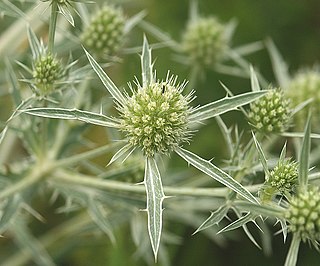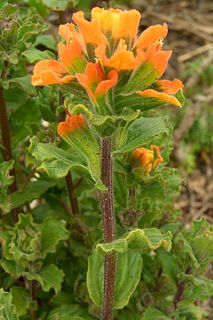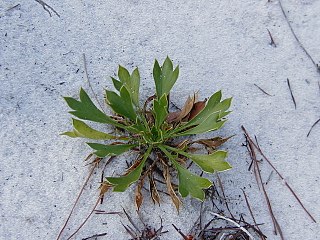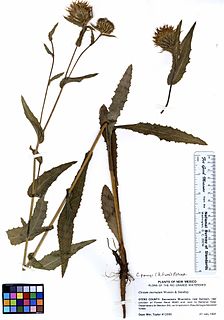
Eryngium is a genus of flowering plants in the family Apiaceae. There are about 250 species. The genus has a cosmopolitan distribution, with the center of diversity in South America. Common names include eryngo and sea holly.

Eryngium maritimum, the sea holly or sea eryngo, or sea eryngium, is a perennial species of flowering plant in the family Apiaceae and native to most European coastlines. It resembles a plume thistle in appearance on account of its burr-shaped flower. Despite its common name, it is not related to true holly, but is an umbellifer.

Eryngium alpinum, the alpine sea holly, alpine eryngo or queen of the Alps, is a herbaceous perennial plant in the family Apiaceae.

Eryngium amethystinum, the amethyst eryngo, Italian eryngo or amethyst sea holly, is a clump-forming, perennial, tap-rooted herb. Its stem is 30 to 50 cm long and is light blue to purple in colour. It has a basal circle of obovate, pinnate, spiny, leathery, mid-green leaves. It flowers in mid to late summer with cylindrical umbels, 2–3 cm long atop silvery blue bracts and branching stems. The plant is native to the eastern Mediterranean and prefers dry places and soils that are rich in calcium.

Eryngium campestre, known as field eryngo, or Watling Street thistle, is a species of Eryngium, which is used medicinally. A member of the family Apiaceae, eryngo is a hairless, thorny perennial plant. The leaves are tough and stiff, whitish-green. The basal leaves are long-stalked, pinnate and spiny. The leaves of this plant are mined by the gall fly, Euleia heraclei.

Eryngium aristulatum, known by the common names California eryngo and Jepson's button celery, is a species of flowering plant in the family Apiaceae.
Eryngium articulatum is a species of flowering plant in the carrot family known by the common names beethistle and jointed coyote thistle. This plant is native to the northwestern United States from California to Idaho, where it is a plant of marshes and riverbanks. This is a sturdy, branching perennial herb with rounded, naked stems reaching maximum heights over one meter. It has a few sparse sharply serrated leaves at nodes and branching points along its stem. Atop the stem is the rounded to egg-shaped flower head, which looks superficially like that of a thistle, mainly due to its spikiness and lavender color. It is fringed with up to 17 spiny, toothed, pointed bracts, each up to about two centimeters long. Each flower head is packed full of small lavender flowers.
Eryngium castrense is a species of flowering plant in the family Apiaceae known by the common name Great Valley eryngo, or Great Valley button celery. This plant is endemic to California, where it grows in wet areas such as vernal pools and ponds in the central part of the state. This is a heavily branched, spiny perennial herb reaching maximum heights of around half a meter. It produces light green to grayish green hairless stems with occasional lobed, oval-shaped leaves. At the tops of the stems are flower heads one to one and a half centimeters wide and rounded or egg-shaped. At the base of each head is an array of 7 to 9 spiny, pointed bracts up to three centimeters long, and sometimes a few smaller bractlets above. The rounded flower head contains many small white to light purple flowers.
Eryngium constancei is a species of flowering plant in the family Apiaceae known by the common name Loch Lomond button celery, or Loch Lomond coyote thistle. It is endemic to California, where it is known from only three occurrences north of the San Francisco Bay Area. One of the populations is at the Loch Lomond Vernal Pool Ecological Reserve at Loch Lomond in Lake County. The plant appears mainly in vernal pools. It is endangered on the state and federal levels.

Castilleja latifolia is a species of Indian paintbrush known by the common name Monterey Indian paintbrush.

Castilleja mendocinensis is a species of Indian paintbrush known by the common name Mendocino Coast Indian paintbrush.
Eryngium mathiasiae is a species of flowering plant in the family Apiaceae known by the common name Mathias' eryngo, or Mathias' button celery.
Eryngium pinnatisectum is an uncommon species of flowering plant in the family Apiaceae, known by the common names Tuolumne eryngo and Tuolumne button celery.
Eryngium racemosum is a rare species of flowering plant in the family Apiaceae known by the common name delta eryngo, or delta button celery.
Eryngium spinosepalum, known by the common names spinysepal eryngo and spiny-sepaled button celery, is an uncommon species of flowering plant in the family Apiaceae.

Eryngium pendletonense is a rare species of flowering plant in the carrot family known by the common name Pendleton button-celery. It is endemic to northern San Diego County, California, where it is known from four occurrences along the coastline between Oceanside and the Orange County border, including land within Camp Pendleton. It grows on vernally moist coastal grassland and coastal sage scrub habitat with clay soils. It was first described as a species in 1999.

Eryngium cuneifolium is a rare species of flowering plant in the carrot family known by the common names wedgeleaf eryngo, wedge-leaved button-snakeroot, and simply snakeroot. It is endemic to the state of Florida in the United States where it is known only from Highlands County. It is one of many rare species that can be found only on the Lake Wales Ridge, an area of high endemism. It was federally listed as an endangered species of the United States in 1987.

Eryngium planum, the blue eryngo or flat sea holly, is a species of flowering plant in the family Apiaceae, native to the area that includes central and southeastern Europe and central Asia. It is an herbaceous perennial thistle growing to 50 cm (20 in) with branched silvery-blue stems, and numerous small blue conical flowerheads surrounded by spiky bracts in summer.

Cirsium parryi, or Parry's thistle, is a species of North American flowering plants in the family Asteraceae. It is native to the southwestern United States, where it has been found in Colorado, Arizona, and New Mexico.

Eryngium aquaticum is a species of flowering plant in the family Apiaceae known by the common name rattlesnakemaster, marsh rattlesnake master, corn-snakeroot, bitter snakeroot, and marsh eryngo. This plant is native to eastern North America.













